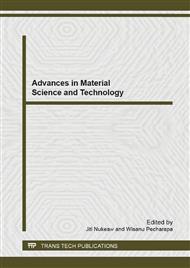[1]
D. J. Friedman, J. F. Geisz, S. R. Kurtz, and J. M. Olson, 1-eV solar cells with GaInNAs active layer, J. Cryst. Growth 195 (1998) 409-415.
DOI: 10.1016/s0022-0248(98)00561-2
Google Scholar
[2]
H. Q. Hou, K. C. Reinhardt, Steven R. Kurtz, J. M. Gee, A. A. Allerman, B. E. klammons, P. C. Chang, and E. D. Jones, Novel lnGaAsN pn Junction for High-Efficiency Multiple junction Solar Cells, The 56th Annual Meeting of the IEEE, 2 (1998) 64-65.
DOI: 10.1109/drc.1998.731123
Google Scholar
[3]
S.R. Kurtz, A.A. Allerman, E.D. Jones, J.M. Gee, J.J. Banas, and B.E. Hammons, InGaAsN solar cells with 1.0 eV band gap, lattice matched to GaAs, Appl. Phys. Lett., 74 (1999) 729-731.
DOI: 10.1063/1.123105
Google Scholar
[4]
S. Sanorpim, F. Nakajima, W. Ono, R. Katayama, and K. Onabe. High-nitrogen-content InGaAsN films on GaAs grown by metalorganic vapor phase epitaxy with TBAs and DMHy, phys. stat. sol. (a) 203 (2006) 1612-1617.
DOI: 10.1002/pssa.200565240
Google Scholar
[5]
P. Kongjaeng, S. Sanorpim, T. Yamamoto, W. Ono, F. Nakajima, R. Katayama, and K. Onabe, Structural investigation of InGaAsN films grown on pseudo-lattice-matched InGaAs substrates by metalorganic vapor phase epitaxy, J. Cryst. Growth, 298 (2007) 111-115.
DOI: 10.1016/j.jcrysgro.2006.10.010
Google Scholar
[6]
H. Kroemer, Polar-on-nonpolar epitaxy, J. Cryst. Growth 81 (1987) 193-204.
Google Scholar
[7]
K. Uesugi, T. Kikuchi, S. Kuboya, S. Sanorpim, and K. Onabe, MOVPE growth of InGaAsN films on Ge(001) on-axis and vicinal substrates, Phys. Status Solidi C (2011) 1-4.
DOI: 10.1002/pssc.201100360
Google Scholar
[8]
D.B. Holt, Antiphase boundary in semiconducting compounds, J. Phys. Chem. Solids 30 (1969) 1297-1308.
Google Scholar
[9]
L. Lazzarini, L. Nasi, G. Salviati, C.Z. Fregonara, Y. Li, L.J. Giling, C. Hardingham, and D.B. Holt, Antiphase disorder in GaAs/Ge heterostructures for solar cells, Micron 31 (2000) 217-221.
DOI: 10.1016/s0968-4328(99)00086-4
Google Scholar
[10]
T.Kuan, and C.A. Chang, "Electron microscope studies of a Ge-GaAs superlattice grown by molecular beam epitaxy, J. Appl. Phys. 54 (1983) 4408-4413.
DOI: 10.1063/1.332688
Google Scholar
[11]
I. Németh, B. Kunert, W.Stolz, and K. Volz, Ways to quantitatively detect antiphase disorder in GaP films grown on Si (001) by transmission electron microscopy, J. Cryst. Growth 310 (2008) 4763-4767.
DOI: 10.1016/j.jcrysgro.2008.07.105
Google Scholar
[12]
M. Wakaki, M. Iwase, Y. Show, K. Koyama, S. Sato, S. Nozaki, and H. Morisaki, Raman spectroscopy of germanium films deposited with cluster-beam technique, Physica B 219&220 (1996) 535-537.
DOI: 10.1016/0921-4526(95)00803-9
Google Scholar
[13]
H.ch. Alt, A.Yu. Egorov, H. Riechert, B. Wiedemann, J.D. Meyer, R.W. Michelmann, and K. Bethge, Local vibrational mode absorption of nitrogen in GaAsN and InGaAsN layers grown by molecular beam epitaxy, Physica B 302–303 (2001) 282-290.
DOI: 10.1016/s0921-4526(01)00442-2
Google Scholar
[14]
A. Hashimoto, T. Kitano, A.K. Nguyen, A. Masuda, A. Yamamoto, S. Tanaka, M. Takahashi, A. Moto, T. Tanabe, and S. Takagishi, Raman characterization of lattice-matched GaInAsN layers grown on GaAs (001) substrates, Sol. Energ. Mat. Sol. Cells 75 (2003) 313-317.
DOI: 10.1016/s0927-0248(02)00174-5
Google Scholar
[15]
I. Németh, B. Kunert, W.Stolz, and K. Volz, Antiphase Boundaries in GaAs/Ge and GaP/Si, Springer Proceedings in Physics 120 (2008) 107-110.
DOI: 10.1007/978-1-4020-8615-1_24
Google Scholar


